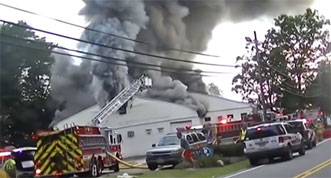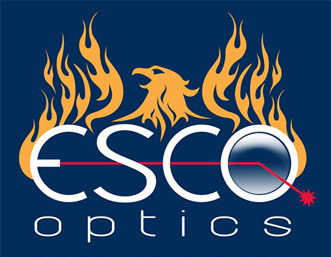Optics Makers Help Each Other Recover After Disasters
It's one light source this industry would rather not deal with.
Fire has affected at least four Northeast optics manufacturers in recent years, destroying inventory, machines and even entire buildings.
No employees or firefighters were injured in any of the fires, though an electrician suffered severe burns while working on damaged equipment at one fire site several days after the fact. None of the fires was deemed suspicious.
Remarkably, each of the businesses was able to bounce back after the fires, resuming production and shipments within weeks or even days. Solid insurance policies helped make that happen, but business leaders said they also had a lot of help from other companies in the optics industry — many of them small, family-operated enterprises. As each disaster struck, competitors temporarily became allies.
"We call it coopetition" — that is, cooperative competition — said Ron Schulmerich, business development manager at Esco Optics Inc. The New Jersey company recently bought a new facility after fire destroyed its original building last year.
"Our competitors literally helped us stay afloat," said John O'Herron Jr., general manager of Angstrom Precision Optics Inc. in Rochester, N.Y. His company was burned out of its original building in 2012, and now rents space from another optics manufacturer.
Schott North America
The most recent and by far the largest of the fires took place March 3 at the Duryea, Pa., facility of Schott North America Inc.
More than 150 firefighters spent about 11 hours extinguishing the blaze, which began around the end of the workday in the plant's 58,000-squre-foot warehouse. The warehouse and its contents, including some finished goods and a large amount of unprocessed glass, were a total loss. Adjacent areas, including production lines and offices, sustained smoke and water damage.
Pennsylvania State Police Fire Marshal Ronald Jarocha estimated damage at more than $50 million but said he could not discuss other details of his investigation. Schott officials said they were still awaiting an official determination of the fire's cause.
Despite the scale of the damage, there was no loss of jobs and no interruption in pay as a result of the fire, according to Michael Platt, who took over as plant manager in August.
"Whether they had work to do or not, they still had a paycheck," Platt said.
Several months before the fire, Schott announced that it would lay off part of its Duryea workforce as a result of transferring melting operations to another of its facilities in Germany. Platt said the Duryea plant had 230 employees before the layoffs and now has 165.
The plant's melting equipment was closest to the warehouse and it suffered the most damage of any machinery. Restoring power to the melting equipment took the longest of any of the recovery efforts, Platt said.
In the immediate aftermath, Schott executives arrived to begin planning recovery efforts while other local optics companies offered to help. Local businesses pitched in too, with one offering its offices and conference rooms for displaced Schott employees to use.
"I can't share who helped, but we're very appreciative of the help we did get," Platt said.
Despite the disruption, the company said, very few orders were delivered late, canceled or lost as a result of the fire.
Esco Optics
The fire at Esco Optics in Oak Ridge, N.J., started on the evening of Aug. 10, 2014, a Sunday, when no one was in the building.
The structure dated back to the 1950s, when current President Lee Steneken's grandfather started the business. A second floor and other sections were added to the building over the years, which Steneken said created plenty of spaces for the fire to spread that were difficult for firefighters to access.

Fire destroyed Esco Optics' original building at 171 Oak Ridge Road in Oak Ridge, N.J., on Aug. 10, 2014. Courtesy of Esco Optics.
The building was a total loss, with a lot of manufacturing projects in progress, machinery and paperwork damaged by fire, smoke or water. As Esco employees salvaged what they could, other optics companies from around the country offered to fabricate and ship some of Esco's outstanding orders. These included Schott, as well as Advanced Glass Industries, LaCroix, Matthews, Sydor and United Lens — some of which Esco had never worked with before, Steneken said.
"It was a humbling experience, [and] it changes your perspective on how to do business," he said.
Steneken and Schulmerich said the cause of the fire remains undetermined. The Passaic County Prosecutor's office denied Photonics Media's requests for records of its investigation of the fire. However, a spokesperson for the prosecutor's office told the news website Suburban Trends shortly after the fire that it appeared to be accidental.
Esco had been manufacturing optical blanks at a smaller, rented facility down the street from its main building. Two weeks after the fire, the company restarted all of its operations there.
Steneken said the business was on solid financial footing before the fire, and with a strong insurance policy, it was able to replace damaged machines and even expand its manufacturing capacity. The staff grew from about 32 employees to 45, and today sales are up 17 percent over last year, Schulmerich said.

Esco Optics integrated a phoenix with flaming wings into its logo after the fire. Courtesy of Esco Optics.
Despite these gains, the layout of Esco's current building isn't ideal, which is why Steneken is eager to move into a new facility across town with double the manufacturing space. Esco bought the property Oct. 28 for $1.35 million, according to Morris County deed records. Schulmerich said operations will move there sometime in the spring.
Asked if, given the growth Esco has experienced, the fire might have been a blessing in disguise, Steneken said, "It was hell for eight months to go through, but when we settle, yes, I think it will be a blessing."
In fact, the fire is now an integral part of Esco's corporate identity — its logo now features a phoenix with wings of flame.
Angstrom Precision Optics
The fire at Angstrom Precision Optics (APO) in Rochester, N.Y., on Aug. 13, 2012, likely started with a mechanical failure, investigators determined.
As they had been used to doing for years, APO employees left that night while an automated milling machine was performing a 20-hour job. John O'Herron Jr., general manager and son of the company's founder, said the theory is that a core drill became stuck, generating heat that ignited the machine's oil-based lubricant. APO now uses water-based lubricants and only rarely operates its machines when no one is in the building.
"We're still not totally OK with running anything overnight yet," he said. "It's still in the back of our minds what happened."
The fire apparently burned inside the milling machine for hours before it was discovered, O'Herron said. Neighbors reported the smell of burning rubber, but its source was a mystery until the building's ventilation system switched on and released the smoke. A police officer on patrol saw the plumes and notified the fire department about 9:17 p.m.
Firefighters forced their way into the building and stopped the fire with a dry chemical fire extinguisher, according to a report from the Monroe County Sheriff's Office and Fire Bureau. Fire damage was contained to the area of the milling machine, but the entire building sustained heavy smoke damage.
Immediately after the fire, O'Herron said, the presidents of two other Rochester optics companies offered help that kept APO going. Jim Sydor of Sydor Optics offered to take over projects for APO that required larger processing machines, while Anthony Marino of Advanced Glass Industries Inc. rented APO space to set up a new shop. APO is still in that space at 1321 Emerson St. today.
"If it wasn't for those two guys, we would have went out of business, probably," O'Herron said of Sydor and Marino. "They made it so it was easy on us."
Advanced Glass Industries
APO had a chance to return the favor 18 months later when a fire that investigators said may have been electrical in origin broke out sometime over the weekend of Feb. 15, 2014, in Marino's shop at 1335 Emerson St. in Rochester. APO took over some jobs for Advanced Glass while the business brought its equipment back online, O'Herron said. Marino declined to comment for this story.
The fire damaged a milling machine and caused heavy smoke damage throughout the building, but the fire "self-extinguished" before spreading to the rest of the shop, according to reports from the Rochester Police Department. Employees discovered the damage when they arrived at work Monday morning, but the company did not alert the fire department.
Days later, a subcontractor working to clean and repair equipment damaged in the incident suffered severe burns to his face and arms while working on a live 480-V electrical bus bar. He told investigators he had been told the bus bar, which was directly above the damaged milling machine, was "de-energized."
Advanced Glass had contracted Mathews Electric Consulting and Investigation Inc. of Michigan to handle equipment repairs after the fire. The Occupational Safety and Health Administration (OSHA) investigated the incident and found the contractor responsible for five violations, including failing to de-energize the bus bar and failing to require the injured subcontractor to wear proper protective gear. Owner Michael Mathews agreed to pay a fine of $14,000 in installments over an 18-month period, according to OSHA records.